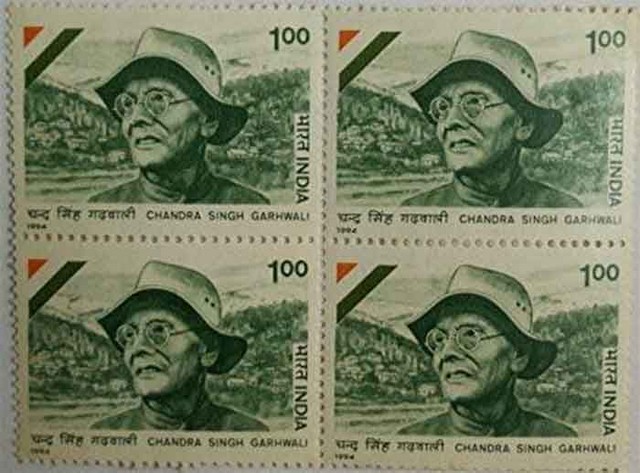By Bharat Dogra
It was a tense day in Peshawar in 1930.The freedom movement under the guidance of Badshah Khan and the overall national leadership of Mahatma Gandhi was progressing from strength to strength. The Khudai Khidmatgars ( literally those who have committed themselves to serving God through service to humanity ) organized by the Badshah ( literally king, so called as he ruled the hearts of Pathans and others, although he personally lived the most frugal and simple life) had proven themselves to be true to their name. In terms of their commitment to non-violence these Pathans, who were earlier known for their violent feuds and revenges, had proved themselves closest to the ideals of non-violence as proclaimed by Mahatma Gandhi.
While the colonial regime sent soldiers armed by the latest weapons to curb them, the Khudai Khidmatgar protestors stood up bravely to them, unarmed and with prayers and freedom slogans on their lips.
Several Indian soldiers who had been brought to suppress them were from Garhwal. They were known as very brave and hardy soldiers from Garhwal region of Himalayas . They had proven themselves capable of winning several tough battles. But here when they were being asked to fire on their own unarmed brothers , they were becoming distressed and tense. How long can this go on ? During holidays when they went to their villages, they heard about the great freedom movement progressing under the leadership of Mahatma Gandhi and they felt happy and proud about this. But here they had been brought, as soldiers known for their loyalty, to suppress the same freedom movement in which their family members took pride and which attracted them too with its nobility and well justified demands. What should they do ?
So the freedom fighters who were clear about their mission and were ready for sacrifice and hence were not as tense as the soldiers were. The freedom fighters were happy with what they were planning to do ( despite all its risks ) but the soldiers were not at all happy with what were they being asked to do.
One unit of the soldiers was led by Chandra Singh Garhwali, a thoughtful soldier who had risen in ranks due to his skills , bravery and leadership qualities. The soldiers placed a lot of their faith and trust in him, and looked up to him to guide them in situations of uncertainty such as the one they faced now. Chandra Singh had been discussing the fast developing situation with his Garhwali soldiers, and while no firm decisions had been made yet, enough words had been exchanged to convince Chandra Singh that many other soldiers of his unit were as almost as disturbed and distressed as he was about the possibility of being asked to fire on unarmed, non-violent protestors and freedom fighters.
Finally the moment of reckoning came. The unarmed protestors stood before the soldiers bravely and calmly while the British commander gave the soldiers the order to fire. Chandra Singh Garhwali was supposed to repeat this order but instead he shouted—Do not fire. Cease fire. The soldiers followed the command of Chandra Singh and not of the much more senior British officer. The news spread like wild fire and brought unprecedented new hope to the freedom movement.
Chandra Singh had no intention of a full-scale rebellion. He knew that his handful of soldiers stood no chance against the huge colonial force. He and his unit soldiers were content with their very important decision to refuse to fire on unarmed, peaceful protestors. Chandra Singh told the British commander very firmly that even if you blow us with your guns and cannons we will not fire on unarmed peaceful protestors.
Needless to add, Chandra Singh and his mates all got very long and stringent imprisonments, even though his case was keenly contested by capable lawyers to avoid death sentence, and later a further reduction of prison sentence could be worked out after a lot of efforts. After his release Chandra Singh involved himself in diverse struggles and constructive activities. He also spent some time with Mahatma Gandhi in his ashram and later participated in Quit India Movement as well, leading to another prison sentence.
After independence he was also involved with the communist movement for some time. A postage stamp was issued in his name . In his last days he was involved in preparing a people-based development plan for a part of the Himalayan region. He had to endure a lot of economic hardships. He died after a life of many struggles and constructive activities in 1979 at the age of 88 following illness.
He and his fellow soldiers will be always remembered by the world peace movement for their courage and sacrifice in refusing to fire on peaceful protesters offering non-violent resistance. Thereby a new and glorious chapter was added and a new dimension was given to the history of non-violent struggles against injustice.
As he and his soldiers were Hindus and the overwhelming majority of the protesters were Pathan Muslims, Chandra Singh and his soldier mates also became a powerful symbol of communal harmony, and remain so to this day.
Rahul Sanskrityayan has written a detailed and great biography of Chandra Singh Garhwali in Hindi. Still his noble sacrifice is not as well known at world level as it deserves to be known, and his story should be told to a larger world audience.
Bharat Dogra is a veteran journalist and author.
12 February 2021
Source: countercurrents.org

